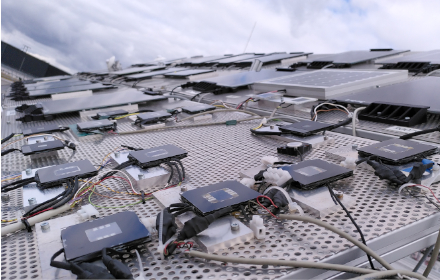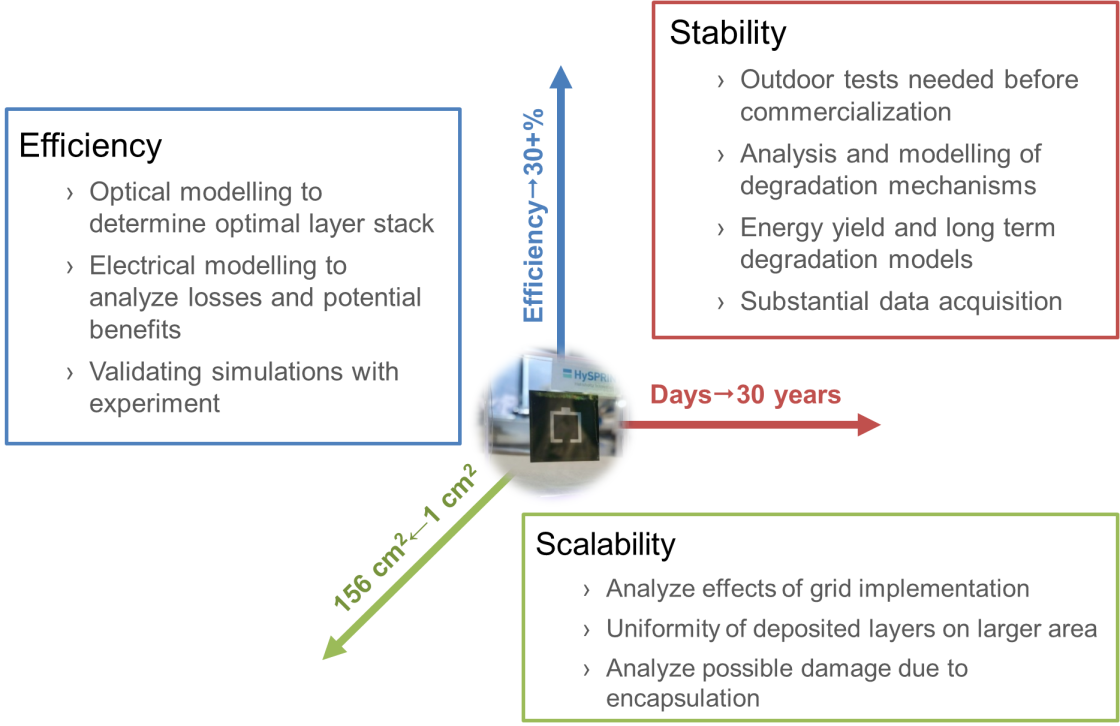Project TAPAS
Objectives
General introduction to perovskite-based solar cells

HZB outdoor test stand on a cloudy day. (© Image: HZB/Maximilian Riedel)
In recent years, inorganic/organic perovskites have emerged and have risen through the ranks as a new semiconductor material class. Because of their excellent optoelectronical properties and the extensive research in this field, it was possible to improve the power conversion efficiencies (PCE) of perovskite single-junction solar cells up to 25.5% in only a few years’ time. With their tunable bandgap around 1.7 eV perovskites offer the possibility of making highly efficient tandem solar cell devices. Perovskites could therefore be combined with other established technologies such as silicon and copper indium gallium selenide (CIGS) solar cells and even create a perovskite/perovskite tandem cell, where a 1.2 eV perovskite bottom cell is used instead of Si or CIGS. But industrialization of perovskite-based tandem solar cells is not straightforward. A lot of research and development activity has to be done in order to significantly exceed the theoretical PCE limit for single-junction devices. Additionally, module fabrication, lifetime stability, recyclability and resource-efficient production processes are also important topics we need to look at while moving forward.
Introduction to the focus of the project
Perovskite-based tandem solar cell research is currently chasing two main goals: improving PCE and improving general device stability. Even though perovskite/silicon tandem devices are at the center of our research, it does not mean we will not explore other tandem technologies. Depending on the possibilities and usefulness we will certainly consider and include other concepts as well (e.g. for modelling concepts). Extensive analytical and modelling analysis is required in order to improve the PCE. The tools for this process will have to be developed at the same time as we experiment with the fabrication of devices. This means the tools will have to be extended for both material classes (perovskite and silicon), so we can understand individual requirements with regard to optical and electronic properties, potential loss mechanisms, and to develop suitable high-efficiency tandem solar cells concepts. To achieve that we need a deep understanding on how perovskite- as well as silicon-based solar cells work which is why the major aim of this project is to share and extend knowledge between the Laboratory of photovoltaics and optoelectronics, University of Ljubljana (LPVOUL) and the Helmholtz-Zentrum Berlin (HZB), and to encourage young scientists to dive into this field and ultimately become experts for organic/inorganic based photovoltaics (PV).

Overview of the main goals in the fields Efficiency, Stability and Scalability within the TAPAS project (Graphic: HZB/Steve Albrecht)
Optical and electrical modelling
To get the most out of monolithic perovskite/silicon tandem solar cells it is very important for both sub-cells to ensure current matching (or close to it), meaning that each sub-cell produces the same amount of current. Optics play a very important role in multi-layer stacks. Therefore, when designing tandem devices, it is standard to use optical modelling software. Additionally, it has also been reported that the highest PCE is achieved through a slight current mismatch because it leads to an increased fill factor (FF) of tandem devices. With the intention of using this effect to our advantage we first need to understand its ins and outs. Here, detailed electrical modelling is needed. The combination of optical and electrical modelling (device level) lets us create an accurate energy yield model, which is among the primary parameters PV system level-wise. Photocurrent and FF are affected by the amount of current generated in each sub-cell and their mismatch, which is again influenced by the spectral changed in the sun light. Air and module temperature on the other hand have a significant impact on output power. Because of that PV modules need to go through complex analysis methods including true weather data. Hence, the collaboration between LPVO-UL, who have developed their own optical models, and HZB with its experimental data measuring system, makes a perfect partnership. The applicants also already did basic calculations of energy yield (Jošt et al., 2018). However, in the scope of the project we want to develop a more advanced model to allow us to study the dependency of temperature and FF in more detail.
Characterization and stability of perovskite-based devices
Talking about the electrical performance of perovskite solar cells is generally very fascinating. Investigating the performance based on current-voltage characteristics (IV-curves), which is a standard PV characterization technique today, of perovskite samples alone can be misleading because of the material’s inherent properties like slow response of diffusing ions. It can also occur that the material itself degrades considerably, because of the strongly varying voltage used in IV-curve measurements. To make precise and correct measurements of the output power it is necessary to always keep track of the maximum power point (MPP). This is also the regular procedure under real world conditions that provides the internal field and charge carrier density and influence the lifetime of a solar cell immensely. For tandem devices this kind of detailed MPP tracking analysis is especially important since irradiation changes may determine which sub-cell is limiting the whole power output, which we will need to consider when designing long-term stable monolithic tandem devices to see how sub-cells behave to each top and bottom cell limiting conditions and how the lifetime of such devices will be affected.
MPP tracking is relevant for both indoor and outdoor analytical procedures. Indoor analysis allows measuring performance data under standard test conditions (STC) and shows properties regarding intrinsic stability. Those conditions can also be changed to help investigate different phenomena. Outdoor measurements, on the other hand, serve to measure full performance cycles with different conditions like varying spectral, shading and temperature conditions. In this project we want to know the foundation of degradation and its counter measures for said devices. Thus, extensive characterization will complement both MPP tracking and long-term stability studies to help us understand more about the origins of degradation. Spectral dependent methods like light beam-induced current (LBIC) and electroluminescence (EL) can help us to figure out changes in absorber or contact materials and even wiring connections. With this information it is possible to optimize fabrication procedures, device design and even material composition. It is our intention to bring this strong structural collaboration between LPVO-UL with its advanced optoelectronic simulations, and HZB with its unique data acquisition system for indoor and outdoor to the European level. The collaboration will make advancements in PCE for both tandem and single-junction devices. Not to forget the outstanding source of testing and modelling data it can provide to improve perovskite-tandem device reliability and hopefully bring this fascinating technology into the hands of consumers.
Aims of the project TAPAS
The collaboration between the two partners is already a very fruitful one and is based on the respective core expertise of LPVO-UL and HZB. However, projects and collaborations, just like the PV sector, must evolve. Therefore, it is important to us to further strengthen this collaboration by developing joint activities under the TAPAS banner with the focus being on characterization, understanding and optimization of perovskite/silicon tandem solar cells. Yes, experimental work is important but another aim of the TAPAS project is to also strengthen the structural side of this partnership by educating and building up a team of researchers from different nationalities with unique skill sets to tackle the challenges we will face with perovskite-based solar cells and PV modules in the upcoming years. By doing that it will be easy to share knowledge efficiently between LPVO-UL and HZB, thus helping both partners learn from each other. We believe that this project will have a positive effect on both LPVO-UL and HZB, even beyond the project’s timescale.
